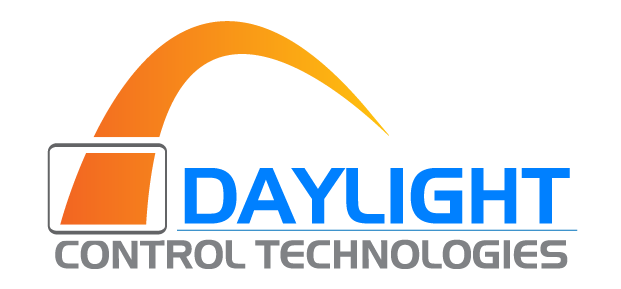Will Automated Shading Ever Penetrate the Mainstream Market?
The U.S. market penetration of automated window shading has been stuck at ~5% for the past few decades (that’s our own estimate, but it’s consistent with most estimates in the open literature). Regardless of how one might define the mainstream market (and there is a standard definition, as described below), it’s certainly a lot bigger than 5%.
It might seem that the recent growth in the market for “smart” devices in general (including smart home platforms and voice assistants, as well as endpoint devices such as smart lightbulbs) portends imminent growth in the automated shading market, too. However, those developments don’t solve the stubborn problem that has kept automated shading out of the hands of mainstream buyers: the lack of a compelling value proposition.
That problem can be solved, but not without new automation capabilities and significant price reductions.
Defining the Mainstream Market
One of the bedrock concepts of marketing is diffusion theory, which holds that new products or technologies penetrate the market sequentially through psychographically distinct purchasing groups.
The concept dates back to the 1940’s, but was crystallized into a systematic theory by Everett Rogers in 1962, turned into a mathematical model by Frank Bass in 1969, and most recently re-popularized by Geoffrey Moore in Crossing the Chasm: Marketing and Selling Disruptive Products to Mainstream Customers (1991, 2014).
The core of diffusion theory is the idea that new products or technologies diffuse into the market via psychographically-distinct groups of purchasers, beginning with risk-tolerant innovators and ending with highly risk-averse laggards:
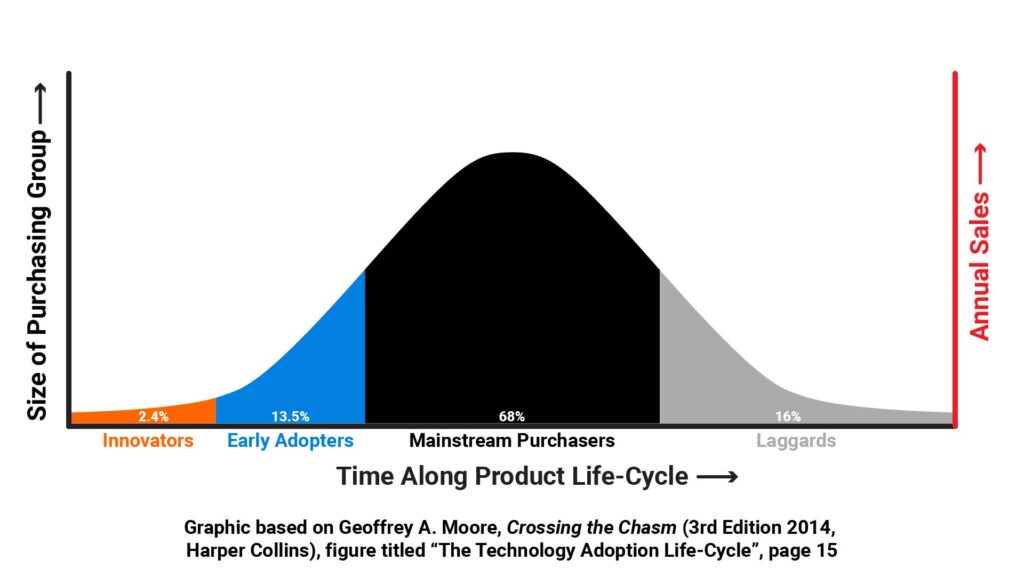
The bell-curve shape reflects the fact that the distribution of purchasing groups is thought to be Gaussian (i.e. normal), and the boundaries between the different groups are thought to fall on multiples of the standard deviation from the mean. Thus, the innovators are supposed to represent about 2.4% of the market, the early adopters 13.5%, the mainstream 68%, and the laggards 16%.
So the mainstream purchasers constitute the bulk of the market, and by the time they’ve adopted the product, the total market penetration will have reached 84%—quite a lucrative target for any commercialization effort.
Conversely, the sub-5% penetration of automated shading implies that it’s barely made a dent among the early adopters, much less penetrated the mainstream market.
Products that have failed to penetrate the mainstream market greatly outnumber those that have succeeded, so automated shading has plenty of company.
Potential Pitfalls Along the Market Life-Cycle
A key aspect of diffusion theory—especially as re-popularized by Moore in Crossing the Chasm—is that the psychographic differences between purchasing groups create potential pitfalls for any product attempting to penetrate the mainstream market.
Specifically, the purchasing groups differ along two major dimensions: risk-tolerance and pragmatism:
- Risk tolerance represents a willingness to commit to a product that’s not yet generally accepted in the market.
- Pragmatism represents a demand for a compelling tangible value proposition.
These differences create what Moore calls “chasms” between the purchasing groups, the most significant of which is at the interface between the early adopters and the mainstream buyers:
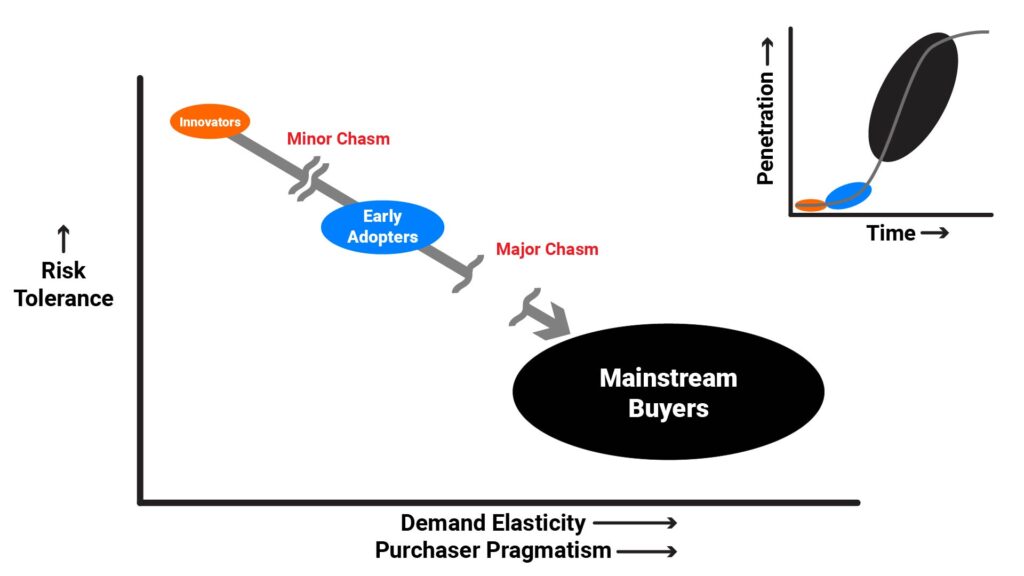
While Moore focuses on the marketing challenges due to these psychographic differences, there are actually two potential chasms before the mainstream: a marketing chasm and a value chasm.
Moore’s Marketing Chasm
Moore’s Crossing the Chasm brought to light a fact that might seem obvious in hindsight: each purchasing group needs a different marketing strategy. If the marketing strategy doesn’t pivot in the right way at the right time, the product will fall into the chasm and never make it to the mainstream.
Crossing the Chasm is probably the most influential marketing book of the 21st century, and for good reason. However, it could be argued that many of the failed products he cites as having fallen into the marketing chasm actually fell into the value chasm.
The Value Chasm
An optimal marketing strategy isn’t necessarily sufficient to ensure full market penetration; the product itself must also be inherently capable of appealing to highly pragmatic, cost-conscious mainstream buyers.
If the product doesn’t offer a compelling value proposition, it will fall into the value chasm and never make it to the mainstream.
This is arguably a far more prevalent scenario than the marketing chasm Moore addresses in Crossing the Chasm. For example, it’s exactly what happens to most crowdfunded products: while a successful crowdfunding campaign seemingly validates the product’s market appeal, it actually only validates appeal among innovators and early adopters. An innovative product can generate plenty of interest in that demographic without actually offering a compelling value proposition—and if that’s the case, no amount of skillful marketing will get it into the mainstream.
Mainstream Value is Driven by Tangible Benefits
Pragmatism among mainstream buyers is manifested as a demand for tangible product benefits, i.e. benefits that are relevant to the lower levels of the pyramid of Maslow’s Hierarchy of Needs:
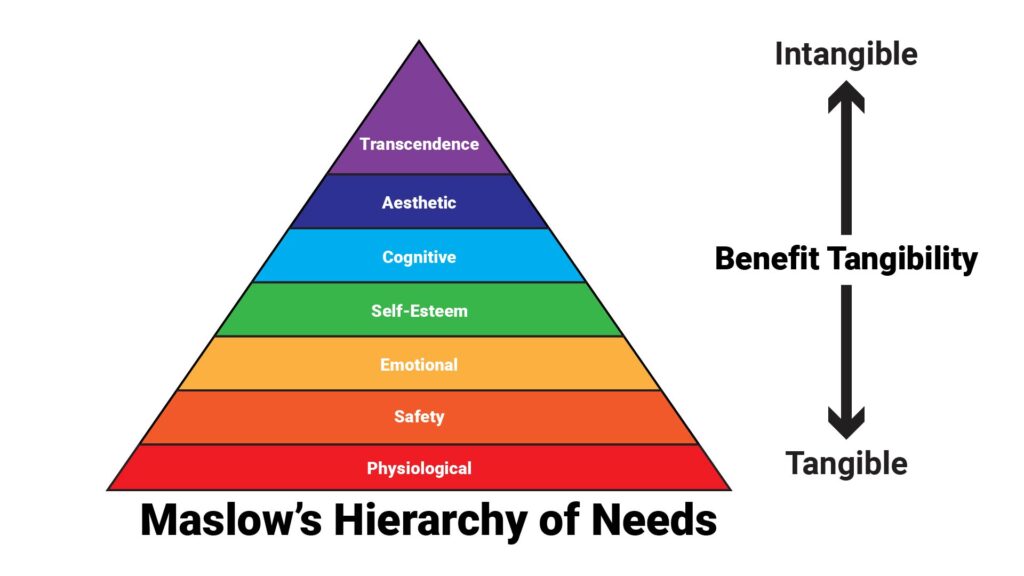
The most compelling value propositions for mainstream buyers are those that meet the needs at the lowest three levels of the pyramid, and especially at the lowest (physiological) level. That’s where the most tangible product benefits like cost savings, labor savings, comfort, and enhanced health resonate with buyers.
Tangible Benefits Provided by Current Automated Shading Products
Current products offer only a subset of the potential tangible benefits of automated window shading. Specifically, current products provide only three of the five possible levels of shading automation, and as a result provide only two of the four potential tangible benefits that could resonate with mainstream buyers:
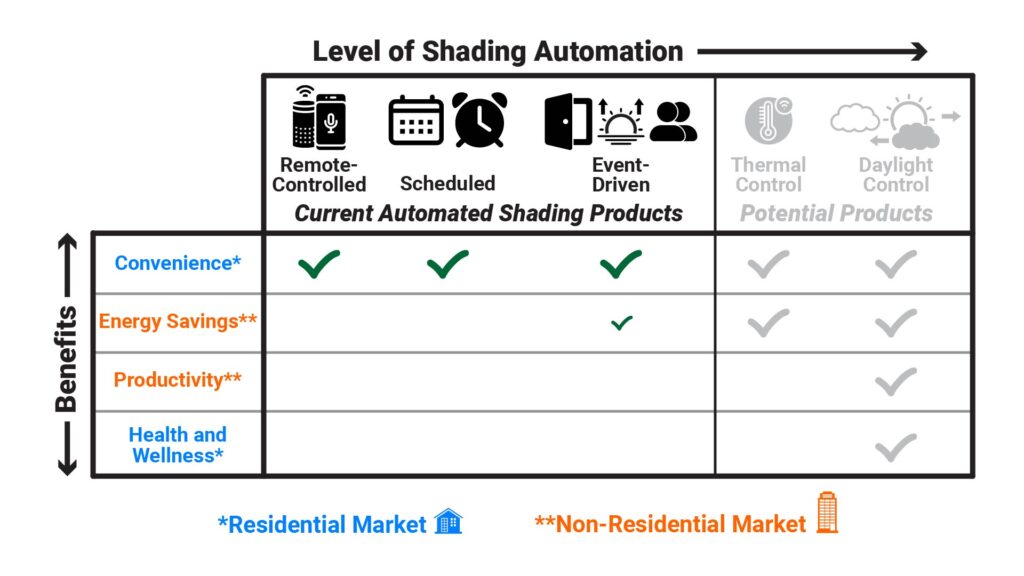
Note that Figure 4 groups the benefits according to two market segments: residential and non-residential (accounting for about 65% and 35% of the potential market, respectively). The distinction is important in terms of product benefits because the decision to buy an automated shading product will generally be made by the building occupants in the residential market, but by other stakeholders in the non-residential market.
We’ll address the two missing benefits (productivity and enhanced health) later in this post; for now, we’ll focus just on the two benefits provided by current automated shading products: convenience and energy savings.
Convenience
Many of the benefits frequently cited for automated shading products could also be provided by manually operated shading (e.g. enhanced daytime comfort or nighttime privacy).
Thus, rather than being direct benefits of automated shading, they are actually byproducts of the fact that automated shading eliminates the physical effort associated with manual shading adjustments.
In fact, enhanced convenience (or labor savings) is one of the most compelling tangible benefits for mainstream buyers: labor-saving devices can achieve virtually 100% market penetration if the benefit-to-cost ratio is sufficiently compelling.
However, enhanced convenience makes for a potentially compelling value proposition only in the residential market; it’s of only secondary importance to purchasers in the non-residential market.
Energy Savings
Optimized window shading can save energy in three ways: it can reduce need for artificial lighting, it can reduce HVAC cooling loads by reducing solar heat gains, and it can reduce both heating and cooling loads by modulating the U-value (thermal conductivity) of the shaded windows.
However, unlike adjusting a window covering for comfort, privacy, or the best view, it’s not practical to achieve significant energy savings through purely manual operation. Therefore, the energy savings achievable through automated shading constitute a primary benefit rather than a byproduct of enhanced convenience.
Energy savings are of interest to both residential and non-residential buyers, but automated window shading can save far more energy in non-residential buildings because the window area to wall area ratios are far larger and the energy use intensities (for both lighting and HVAC) are far higher.
As with residential labor-saving devices, energy-saving devices can achieve deep penetration in non-residential buildings—if the benefit to cost ratio is sufficiently compelling.
By the way, the energy savings checkmark in Figure 4 is smaller than the other checkmarks because current products provide only a fraction of the energy savings theoretically possible with automated shading; more on that later.
The Mainstream Market is Elastic
Another defining feature of the mainstream market is its elasticity. Elasticity is usually thought of in the context of the price elasticity of demand, but mainstream demand is also elastic with the degree of benefits provided by a product.
In fact, when a product is bought on the basis of tangible benefits, the decision to buy is based on a conscious or subconscious benefit-to-cost calculation.
The benefit-to-cost threshold for deciding to buy will obviously vary across the buying population. But if that threshold has a Gaussian distribution and if there are a lot of potential buyers, then the market will be elastic with both benefit and cost—and that’s most definitely the case with any mainstream market.
Specifically, demand among mainstream purchasers varies inversely with the product’s perceived price-to-benefit ratio.
Let’s look at exactly how that works in the context of the two potentially compelling benefits provided by current automated shading products: residential convenience and non-residential energy savings.
Elasticity in the Market for Residential Labor-Saving Appliances
We first studied elasticity in the residential labor-savings appliances market back in the early 2000’s by analyzing the penetrations of appliances that had already reached the peaks of their growth curves.
First, we developed a convenience model to estimate the average effective labor savings per day provided by each type of appliance (in minutes saved, weighted by the perceived reduction in physical effort), and then plotted the market penetration of each type of appliance against its estimated price-to-convenience ratio. Here are the results:
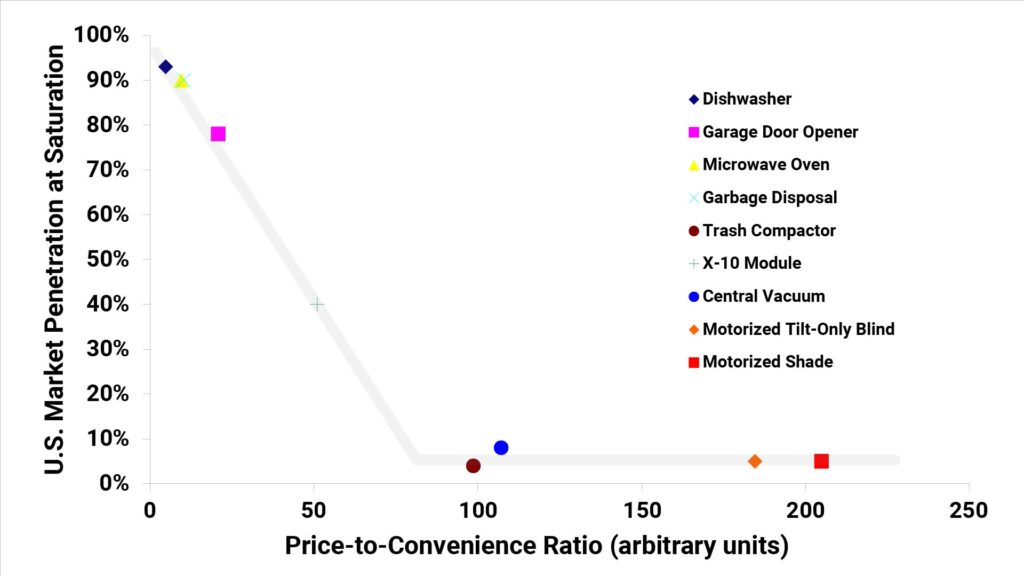
The ultimate market penetration decreased linearly with increasing Price-to-Convenience ratio until a P/C of about 80, at which point penetration bottomed-out at about 5%. Recall from Figure 1 that innovators and early adopters are together thought to account for about 16% of the market. So, in the framework of classic diffusion theory (or Moore’s chasm theory), the products along the flat line of the curve of Figure 5 were never even fully embraced by the early adopters, much less by the mainstream buyers.
Note that Figure 5 includes two automated shading products: a motorized blind and a motorized shade. These were typical of the lowest-cost automated shading products available at the time, with prices of $200 and $300 (respectively) in current-year dollars. Their automation capabilities were limited to just remote-controlled operation, but that is sufficient to deliver most of the potential convenience benefit of automated shading.
Obviously, the price-to-convenience ratios of these automated shading products were far to the right of the sloping portion of the curve, and about 4X too large to achieve the kind of penetration associated with the mainstream market.
Some of today’s automated shading products do offer greater automation capability (such as scheduled and event-driven automation, as previously shown in Figure 4) while costing only about half as much. However, while scheduled and event-driven operation do provide ancillary benefits, they doesn’t provide significantly more convenience than the motorized remote-controlled operation of the older products of Figure 5.
Thus, current products have only a 2X advantage in price-to-convenience ratio relative to the older products—enough to be able to eke out penetrations of perhaps as much as 10%, but not nearly enough to approach mainstream numbers.
Therefore, automated shading products are going to have to offer another compelling value proposition (besides convenience) if they’re going to penetrate the mainstream market.
By the way, the inverse linear relationship between penetration and the price-to-convenience ratio isn’t due just to a Gaussian distribution of purchasing thresholds among buyers; it’s also due to the fact that the actual labor saved by a given appliance will also vary from purchaser to purchaser.
Elasticity in the Market for Non-Residential Energy-Efficient Building Upgrades
Demand is also highly elastic in the context of the second tangible benefit offered by today’s automated shading products: energy savings in non-residential buildings.
A non-residential energy-saving product’s salient price-to-benefit metric is the payback period—the ratio of its up-front cost to the value of its annual energy savings.
We first studied elasticity in this market back in the early 2000’s by correlating the regional market penetration of various non-residential energy-saving technologies with the electricity prices in the corresponding regions. Conveniently, the 1995 version of the Energy Information Administration’s Commercial Buildings Energy Consumption Survey (CBECS) provided all the information necessary to do this, which in turn enabled us to plot market penetration versus average payback period:

Note that, unlike Figure 5, Figure 6 doesn’t include any automated shading products. By the time of the 1995 CBECS, government labs had demonstrated that automated shading—when coupled with daylight-harvesting lighting controls—could save significant amounts of energy in office buildings. However, the technology was unfamiliar and complex (and still is), and it couldn’t support a payback period shorter than about 20–30 years. Hence, penetration in the market for non-residential energy-saving upgrades was negligible.
Also note that, unlike the residential products of Figure 5, the three non-residential products of Figure 6 had not yet reached market saturation and were in different stages along their adoption life-cycles.
In particular, occupancy-sensing light switches were relatively new to the market and initially had a reputation for erratic operation. Accordingly, the penetrations were no greater than 20% (and only 5% in some regions of the U.S.), which meant that only innovators or early adopters had bought them when this data was collected.
Nevertheless, penetration of all three technologies still varied inversely with average payback period, and with about the same slope.
This makes sense because, while innovators and early adopters are supposed to be less pragmatic than mainstream buyers, they are undoubtedly still influenced by price and benefit considerations to at least some degree.
What would the penetration curves look like if all the products had been at market saturation, and if occupancy-sensing light switches had outgrown their reputation for erratic operation?
More data is available today to answer that question, but back in the early 2000’s we had to project the ultimate market penetrations using a Bass diffusion model:
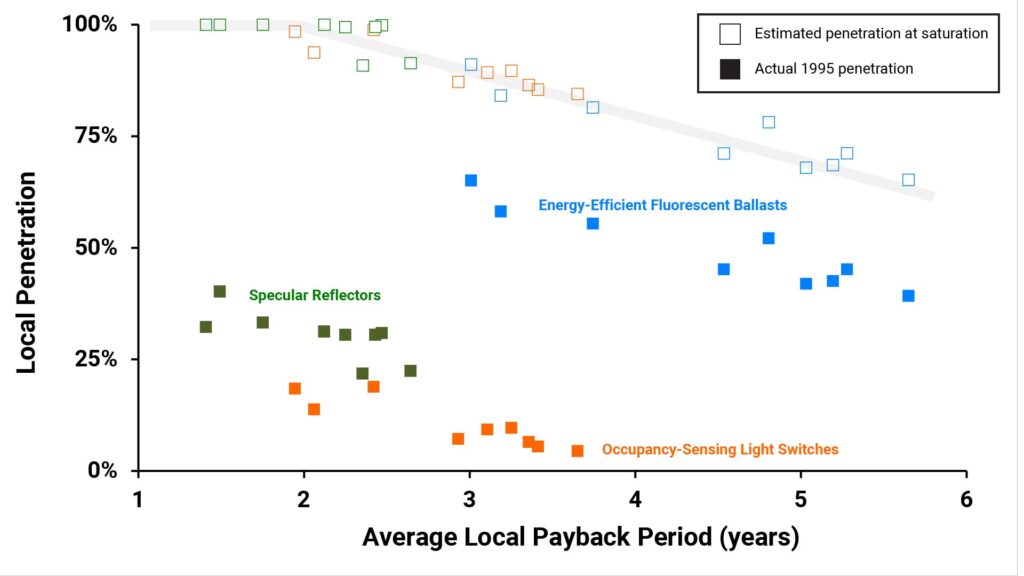
As it turned out, the rapid emergence of LED lighting rendered specular reflectors and fluorescent ballasts obsolete, keeping the latter from reaching the ultimate penetrations of Figure 7.
However, the analysis still showed that—just as in the market for residential labor-saving appliances—penetration in the market for non-residential energy-saving upgrades varies inversely with a price-to-benefit ratio, i.e. the payback period in this case. As with residential labor-saving appliances, this is due not just to the Gaussian distribution of purchasing thresholds among buyers, but also to the fact that the actual payback period of a given technology will vary from building to building.
The non-residential market has changed significantly in the 30 years since the 1995 CBECS (upon which the data of Figures 6 and 7 were based). Back then, a product needed a market-average payback period of no greater than about 10 years to penetrate the mainstream market; today, that has increased to about 16 years.
Unfortunately, the energy-saving payback period of current automated shading products is still about 20–30 years. The cost of automated shading has dropped a bit and electricity prices have increased, but those changes have been offset by significant reductions in the average energy-use intensity in non-residential buildings—so market penetration remains negligible.
On the other hand, contrary to the situation with the residential market, automated shading might not need to offer a completely different primary benefit in order to offer compelling value in the non-residential market. That’s because current automated shading products appear to have enough room for improvement (in both affordability and energy-savings capability) to get down to a market-acceptable payback period.
Toward a Mainstream Automated Shading Technology
The preceding discussion has made the case that automated shading must evolve if it’s going to have any chance of penetrating the mainstream market:
- Convenience alone isn’t a sufficient benefit to appeal to mainstream residential buyers, because price reductions alone won’t be enough to provide a compelling price-to-convenience ratio.
- Energy savings are a potentially compelling benefit for non-residential buyers, but the amount of energy savings must increase—and prices must decrease—in order to provide an appealingly short payback period.
This will be possible only with automation capabilities beyond those of current products. Two automation capabilities, in particular, could provide benefits that would resonate with mainstream buyers: responsive thermal control and responsive daylight control.
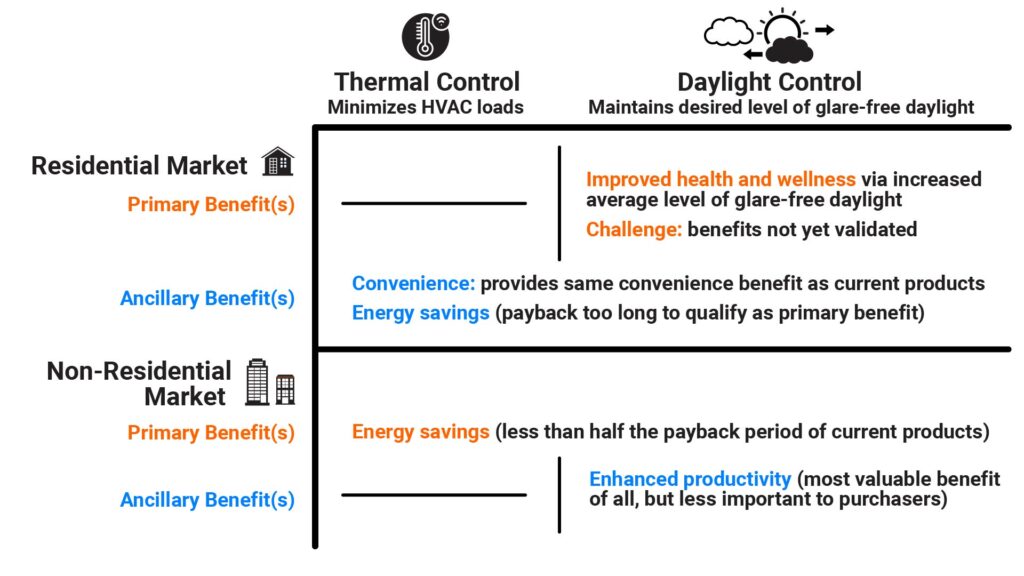
Responsive Thermal Control
Responsive thermal control is the capability to adjust the shading to minimize loads on the HVAC system. Current automated shading products must be integrated with the HVAC system in order to do this, which increases cost and complexity.
However, emerging interoperability-oriented protocols like Matter offer the potential to reduce this complexity. Further, improved sensors and increased processing capacity could potentially enable automated shading products to maximize energy savings autonomously (without need for integration with the HVAC system) at little or no increase in cost.
These advances could significantly reduce the payback period in non-residential energy-saving applications, while also making energy savings more plausible as an ancillary benefit for residential purchasers.
Responsive Daylight Control
Responsive daylight control is the capability to automatically adjust window shading to maintain a desired level of glare-free daylight. Since windows with manually operated window coverings are chronically over-shaded, responsive daylight control substantially increases the average level of glare-free natural illumination. This, in turn, offers three benefits:
- The additional natural illumination can be “harvested” by a daylight-harvesting lighting control to reduce the energy consumed in artificial lighting. When coupled with responsive thermal control as described above, this would potentially enable automated shading products to provide a payback period short enough to appeal to non-residential mainstream buyers.
- Studies have shown that increased natural illumination can increase (1) productivity in office buildings, (2) rates of learning in schools, and (3) sales in retail stores. Purchasers of non-residential building systems are generally more interested in building operating costs than in the potential for such positive impacts on the activities of the building occupants, but these would still be significant secondary benefits.
- Studies have found a correlation between increased exposure to daylight and improvements in emotional and physiological health. To date, these studies have focused on relatively short-term exposure to unfiltered direct sunlight, but it’s plausible that the increased long-term level of glare-free daylight provided by responsive daylight control would also offer similar health benefits. If such benefits are validated, they would potentially be more compelling to mainstream residential customers than the convenience provided by current automated shading products.
For these reasons, responsive daylight control is arguably the most valuable form of automated shading. However, it’s also the hardest to implement cost-effectively; in fact, actual use of responsive daylight control in U.S. buildings is negligible.
Responsive daylight control systems can be broadly grouped into two categories: those using motorized window coverings and those using Smart Windows:
- Most of the current interest in commercializing responsive daylight control is focused on Smart Windows because they have no moving parts and operate unobtrusively. Unfortunately, the technology is too expensive, even for early adopters. In fact, motorized window coverings will always be far more cost-effective than Smart Windows for responsive daylight control.
- While potentially inexpensive enough for mainstream use, responsive daylight control systems using motorized window coverings present the risk of obtrusive and erratic operation, potentially derailing any attempt to penetrate the mainstream market. These problems aren’t insurmountable, but efforts to solve them seem to have been overcome by interest in Smart Windows.
Automated Shading Products Need More Autonomy, not More Connectivity
The earliest electric products became “smarter” through integration of crude digital logic and (eventually) microcontrollers, along with mechanical and (eventually) electronic sensors. These developments gave products autonomous intelligence, enabling them to do useful things with reduced human involvement.
But beginning in the 2000’s, the trend shifted toward increased connectivity, with the aim of enabling products to leverage “distributed intelligence” from other devices and the cloud.
Automated shading products have followed the same evolutionary pattern—first autonomy, then connectivity:

The most recent development has been the emergence of Matter, an interoperability-oriented wireless protocol that promises to simply the integration of automated shading products with other smart devices. Matter will offer two key benefits for automated shading:
- It will allow purchasers to use smart products from different manufacturers via the same user interface and automation platform.
- It will enable leveraging of sensor information and processing power from other sources to provide more sophisticated shading automation.
However—at least when it comes to automated shading—those benefits aren’t relevant to the mainstream market.
The first reason is that they presuppose the presence of multiple disparate smart devices, and that’s likely only among innovators and early adopters, not mainstream buyers.
Second, while Matter could someday enable an inexpensive automated shading product to work with other smart devices to provide responsive daylight and thermal control, the value proposition won’t be compelling if those other devices aren’t already present and must be purchased.
The Solution: Autonomous Intelligence via Integrated Sensors and Advanced Algorithms
Connectivity obviously isn’t the only technology area that has seen dramatic improvements in the past decade:
- Microcontrollers have become radically more power and cost-efficient (in fact, that’s what has enabled enhanced connectivity in the first place), to the point that even the least expensive smart product has substantial spare processing capacity.
- The exploding market for Personal Electronic Devices (especially smartphones and smart watches) has prompted the development of a variety of integrated digital sensors that didn’t exist even a decade ago.
These two developments offer the potential to add responsive daylight and thermal control to new automated shading products at very low incremental cost. Not only does this approach put the sensors in the best possible location to collect the required data (i.e. at the automated shading product itself), it also enables a much more compelling value proposition for mainstream buyers than if multiple devices were needed to obtain the same capability.
Of course, the downside of this “autonomous intelligence” approach is that it would require hardware modifications to existing products to add the required sensors.
However, that’s really not much of a downside since existing products have a market penetration of less than 5%.
The technology is available to penetrate the huge untapped mainstream market for automated shading—all that’s needed is some market-driven product development.
